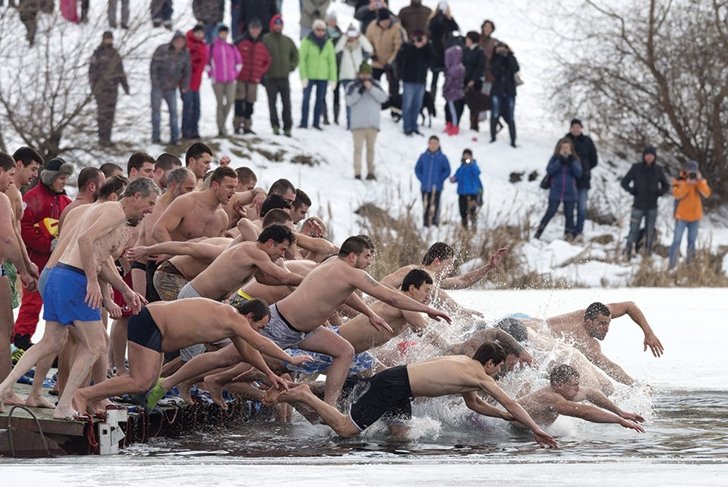
While many people sleep in on New Year\’s morning or nurse a pounding headache, some brave (think crazy?) souls are jumping in frigid lakes, rivers, and oceans … just because they can. If a polar bear swim is on your bucket list, check our our survival tips.
What better way to welcome a new year of possibilities than an exhilarating dip with dozens, hundreds, and even thousands of your closest crazies … um, friends, that is. If you’ve ever sat on the sidelines of a polar bear swim and contemplated getting in on the action, this is your year!
It’s c-c-cold
Good, I’m glad we got that out of the way. That is both the most common phrase at a New Year’s Day polar bear swim and the icy truth about what you will experience. The annual January 1st plunge is a Western world phenomenon, and one is sure to be taking place at an ocean, lake, or pond near you.
Nothing is a better narrative of the human condition than a multitude of people standing and waiting to hurl themselves into water (slightly above the temperature of ice) all at once. If this proposition sounds both exciting and daunting, read on to see what you can do to prepare for the event.
A long history
The polar bear swim has a proud tradition in North America, with the first swim dating back to 1903 in Coney Island, New York. Vancouver’s swim began in 1920 with a dozen or so brave souls and has now grown to more than 2,550 registered participants at English Bay alone.
Widely regarded as the father of Vancouver’s Polar Bear Swim, Peter Pantages believed that people should swim every day of the year.
The perks
Although it poses risks to certain groups of individuals, cold water immersion (CWI) may also provide some health benefits to others, such as
- accelerated metabolism
- decreased general swelling and pain
- reduced perception of fatigue
Preparation for polar
Some swimmers choose to slowly acclimatize themselves to the frigid temperatures by taking showers that are progressively colder and colder over the approaching months. They then progress to ice baths in December, all in the hopes that the polar bear swim won’t seem so cold.
It will still be cold, but this method will help temper your body’s reaction to the plunge and should help you recover faster. The only other way to truly prepare yourself is to decide whether or not you want to wear a costume (as many choose to do) or your favourite swim trunks or bathing suit. Ensure your friends don’t bail at the last minute by ridiculing them mercilessly when they discuss the idea of “doing it next year instead.”
No turning back
3, 2, 1 … Happy New Year! After you return home (or perhaps before you go out to celebrate), you’ll want to pack a bag of polar bear essentials, so you can enjoy the experience in relative comfort. As a veteran of many a chilly plunge, my advice is not to underestimate how cold you will get and how warm you will want to be.
Dress warmly
On top of your bathing suit or costume, dress for winter. This means layers and warmth. I recommend an inner layer of a quick dry material (that wicks moisture away from the skin), a sweater, and pants (it’s best to avoid cotton as this material soaks up water and will stay heavy and cold), and a thick winter jacket.
Towel off
Bring a large towel or two to dry yourself as quickly as possible once you exit the water.
Protect your feet
You may also want to consider footwear that you can wear into the water. Many shorelines are rocky or have shells, and these are a hazard to cold toes.
Monitor yourself
Most participants are in and out of the water within 15 seconds. Some choose to actually go for a swim, but if you find you’re getting numb, or your limbs aren’t functioning as normal, it’s time to get out.
Warm up
Finally, you should have a warm beverage waiting and a solid escape plan. You’ll crave a warm shower, bath, or hot tub.
Exercise proper caution, plan carefully, add a little bit of eccentricity, and you may just get hooked. See you there!
Not for everyone
If you’re a child, pregnant, have a heart condition, or are inebriated, it’s not recommended that you participate in this event. If you have any health concerns, consult your health care practitioner before taking the plunge.
Aprés swim
After you arrive home from the swim, your body’s circulation should be in high gear, trying to pump blood back to your fingers and toes. If you find that you suffer from poor circulation in general, you might consider taking the amino acid supplement L-arginine, or you can try eating more cocoa or garlic. For more information on supplements to improve your circulation, consult your local health or nutrition store, or your health care practitioner.

